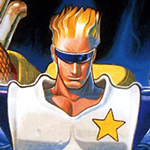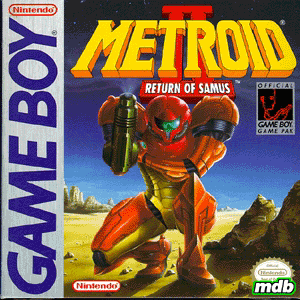 Review by: Devin Monnens
Review by: Devin Monnens
Original Publish Date: Pending
Final rating (original): Metroid II is a small, but meaty adventure.
Final rating (3DS VC): Buy it if you’ve never played the original.
 It’s been 20 years since Metroid II was first released on the Game Boy in November 1991. I have fond memories of exploring the depths of SR388, seeking out the Metroids in the mysterious underground cities of the Chozo, but after 20 years, Metroid II still feels like the ignored child of the series, often shunned over the limitations of the hardware and forgotten in the light of its successful sibling, Super Metroid. However, Metroid II is an incredibly important part of the series, setting the story for Super and the games that followed. In fact, Metroid II’s story and setting are two reasons why I love the game so much, though most of this is communicated through a detailed instruction manual. To risk overstating it, without Metroid II, there would be no Super Metroid, and thus the series would be entirely different.
It’s been 20 years since Metroid II was first released on the Game Boy in November 1991. I have fond memories of exploring the depths of SR388, seeking out the Metroids in the mysterious underground cities of the Chozo, but after 20 years, Metroid II still feels like the ignored child of the series, often shunned over the limitations of the hardware and forgotten in the light of its successful sibling, Super Metroid. However, Metroid II is an incredibly important part of the series, setting the story for Super and the games that followed. In fact, Metroid II’s story and setting are two reasons why I love the game so much, though most of this is communicated through a detailed instruction manual. To risk overstating it, without Metroid II, there would be no Super Metroid, and thus the series would be entirely different.
Though missing the bells and whistles of later titles, Metroid II is in many ways a realization of how the original was supposed to play. It was here Samus first discovered the Space Jump, Jump Ball, and Plasma Beam, not to mention the Spider Ball, which at the time required no magnetic tracks – just a wall. And while Samus can’t shoot diagonally or Wall Jump, there ultimately doesn’t seem to be much need for those abilities on SR388 (or enough buttons). The only real snag is the Spider Ball can be a little difficult.
The graphics to Metroid II still hold out pretty well today too, despite the color limitations. While the GameBoy has a bad reputation for its small, blurry screen, this was a result of the original GB’s design, and Metroid II plays well on later models, looking particularly nice on the 3DS Virtual Console. Samus is very well-drawn, especially the new Varia design, which makes her feel like a killing machine. The Metroids are also impressive on the small screen, particularly the Queen herself. The tiles are especially detailed, reeking of age and time, but unfortunately SR388 lacks in visual variety, limited mostly to rocks and ruins.
The game is a mixed bag in terms of sound. There are plenty of fan favorites, such as The Tunnel, Omega, and the Ending, but the game is often criticized for silence. However, these ambient tracks contribute to the game’s atmosphere, particularly the buzzing insects of the Sewer System. Metroid II also builds tension through silence, especially when you spot an empty Metroid shell and never know when the boss music will explode out of the speakers. But admittedly, dripping water does limit the sense of space felt when exploring giant subterranean ruins.
Metroid II is designed differently from any other game in the series. Your mission is to clear out the Metroids in each level of the caves, exploring a series of large ruins in the process. While there is little to no backtracking, each ruins area is a small maze in and of itself. However, since many rooms are repeated, and there is no map, the confusing passages of SR388 become a logistical nightmare, especially when you are searching for that one last Metroid. Items are also well-hidden, with some cleverly-constructed item rooms, but you don’t need to collect them all, although even the Jump Ball will help tremendously.
Unfortunately, while other Metroids combine flying and crawling enemies, Metroid II tends to have only one type of enemy on screen at the same time, so is less exciting. What’s more, many of the enemies are carbon copies. Considering the developers were changing the map as late as October, Metroid II ultimately feels as if it wasn’t rushed to meet the holiday release schedule. Two or three more months of polish would have certainly made a difference.
If you’ve never played Metroid II, you really are doing yourself a disservice. While it has its sore spots, the game is a solid outing that still holds up after 20 years. And at about 6-8 hours your first time through, Metroid II is a small, but meaty adventure.
 Metroid II on the 3DS Virtual Console: by CapCom
Metroid II on the 3DS Virtual Console: by CapCom
Metroid II has finally been re-released for the 3DS Virtual Console! After being out of print for more than 10 years, today’s Metroid fans can now purchase the game direct from Nintendo. But just how does Metroid II play on the VC? And if you already have a copy of the real deal, should you get another one? Let’s find out!
After loading Metroid II, you’ll immediately notice the VC is in black and white, but has a much cleaner picture than even the SP! You can’t get an image this clear in black and white except perhaps on the GameBoy Player or an emulator. The graphics are crisp, allowing you to make out small graphical detaile, and the stark grayscale fits well with the sci fi world of Metroid. There’s even the sprite flicker of the original. However, lack of color functionality is a big minus, especially considering how easily it could have been implemented. I get the impression Nintendo made the VC to show how they wanted the GB to play back in 1989, not how we’ve expected to play it. Hopefully they won’t charge for color…
The audio is startling. While the GB used stereo, unlike the 3DS, it was equipped with a single speaker, so you could only hear stereo with headphones. You can really tell where the sound channels were blocked out due to SFX (like during the earthquakes), and the item collect jingle blares from both speakers.
The controls are a mixed bag. The Circle Pad is decent, but ultimately feels unnatural for a 2D game because it slides around so much, and it is not accurate enough. For instance, when you roll into a corner and activate the Spider Ball, you have to be very precise with the Circle Pad to go anywhere, whereas the D-Pad will get you moving just fine. 2D gameplay simply requires precise controls. Sadly, the D-Pad is not directly opposite the ABXY buttons, so it’s more tiring on the thumb, and the buttons are a little small and hard. Worse, only the actual Start button is mapped to Start, and it’s too far away from your thumb, so you have to break concentration to use it. Thankfully, Select was also mapped to Y, which makes using Missiles a breeze. Nintendo could have just as easily mapped Start to X or R, too…
The biggest change to gameplay is the VC has one restore point. You can save your game state by tapping the touch screen, and you can load that restore point as many times as needed. You can make best use of this before a boss, difficult section or, in other titles, a chance game, and it’s real quick to save and reload. Nintendo at least knows how gaming has changed!
Metroid II is $3.99 plus 16 cents tax. Unfortunately, you can’t pay just $4.15, as like all the other console download services (except Steam!), you have to buy credits in amounts of $5, $10, $20, or $50. Having 85 cents floating in Nintendo’s bank doesn’t make me very happy. It doesn’t seem like a lot, but when you have a million people buying from your shop, it adds up quickly. And you’ll never spend just 85 cents. Of course, it’s still a lot cheaper than the $10 average (including shipping) Metroid II currently resells for, but it still smells like a scam.
Ultimately, if you already have a copy of Metroid II and a 3DS, a clearer picture and save states might not make a sale, but I was ultimately impressed by it. In that case, the only reason you might want to buy it is if your battery has died out, but that only seems to have happened with my Japanese copies… However, if you have a 3DS and haven’t played Metroid II, you’re missing out on a forgotten classic and should go and buy it now! Oh yeah, you can access the instruction manual by hitting the Home button inside the game and hitting the Manual option, or we have one right here in PDF form.
